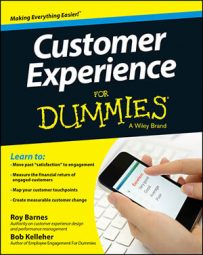Perhaps author Edward Hodnett said it best: “If you don’t ask the right questions, you don’t get the right answers. Only the inquiring mind solves problems.” Here, you discover the right questions to ask to diagnose your organization’s customer experience woes.
The majority of customer experience problems arise in one of the four following areas:
Personnel
Processes and technology
Customers
Financials
Gather together a group of customer experience co-conspirators to review these questions. Discard the questions that don’t quite apply to your situation, and add ones that do. Then take your best shot at answering the questions.
When you do, consider using a three-point scale, where 1 correlates to “not doing this,” 2 equals “partially doing this,” and 3 equals “yes, doing this.” If you identify areas where you’re not quite making the grade, take the necessary steps to improve. Then come back in six months and answer the questions again.
Questions about personnel
Following are several questions pertaining to personnel:
Have you clearly articulated the experience you want your customers to receive, in a way that all employees can understand?
Are you hiring for the best basic customer service traits, such as warmth, empathy, optimism, detail-orientation, and teamwork?
Are you recruiting new customer-facing employees with the skills and abilities to deliver the customer experience you want?
Have you profiled your existing successful customer-facing employees to identify traits that work in your organization?
Do you use an on-the-job “trial” period to determine the customer-centricity of a potential employee?
Does your new-employee onboarding process support your organization’s customer experience mindset?
Are your customer-facing new hires creative problem-solvers? Do they have unusual and unpredictable solutions to common customer issues?
If you owned a small customer service firm that had only one customer service rep, would you hire each of your existing employees for that role?
How do you recognize and reward employees who deliver an outstanding customer experience?
Do you have the same customer experience delivery expectation for your “internal” (that is, those departments that don’t serve external customers but serve other internal areas instead) customer delivery support teams?
Have you reviewed your policies and standard operating procedures (SOPs) to identify those that prevent your employees from delivering an awesome customer experience?
If given the choice to steal something from your organization, would your competitors choose your people?
Questions about processes and technology
Here are some questions you should ask about processes and technology:
Do you give employees enough time to listen to, diagnose, and solve individual customer problems?
Is it extremely easy for your customers to find one telephone number or email address to contact you about a service issue?
Does your IVR menu have an appropriately limited number of selections?
Can a customer press zero at any time within your IVR system to talk to a customer service representative? (Watch out: How many customer service representatives are you willing to employ to deal with questions?)
Do your customer-facing systems pass the necessary customer information and data from touchpoint to touchpoint so that an ongoing customer dialogue can be maintained throughout the customer journey?
Do you have a good selection of leading and lagging customer-performance metrics regarding the use of your process and technology?
Are all your key customer-facing processes optimized and mobile enabled?
Questions about customers
Following are several questions pertaining to customers:
Do you know what your customers’ expectations are of your service, product, and brand?
Do you proactively solicit customer feedback at your key customer touchpoints?
Do you immediately respond to customer complaints and concerns, no matter what channel is used to communicate with you?
Do you actively promote your brand, products, and services on all appropriate social media outlets?
Do you proactively manage customer complaints and dialogues on all social media outlets?
Have you mapped all your customer touchpoints?
Do you know who “owns” each customer touchpoint within your organization — that is, who is accountable and responsible for improving it?
Questions about financials
Here are some key questions related to financials. (Note that some of these are of the “yes/no” variety. The three-point scale we mentioned earlier may not apply here.)
Have you created a list of “perfect” customer behaviors?
Have you worked with your CFO or financial team to identify some elements of your return on customer experience (ROCE) model?
Are your products and services commodities?
Is customer experience a competitive differentiator in your industry?
Do you know all the costs associated with poor service in your organization — for example, customer defection, churn, buy-backs, cancellations, nonrenewals?
Have you calculated the costs to acquire a new customer versus the costs to retain an existing one?
Have you determined what percentage of customer defection is for price-related issues versus service-related issues?

